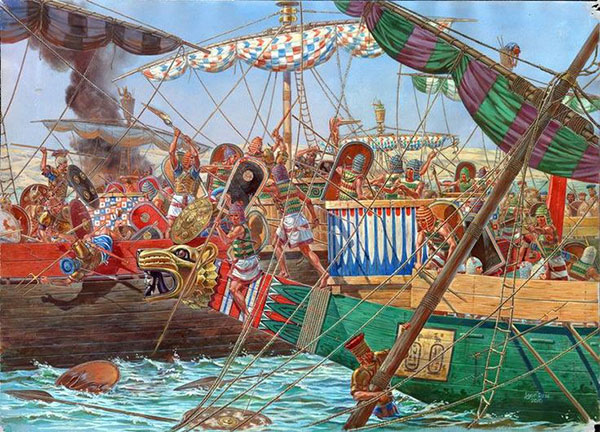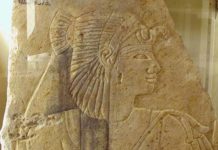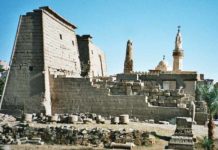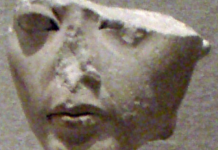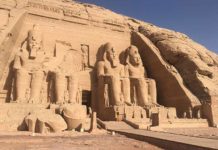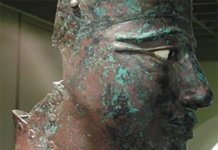From the beginning of its history Egypt relied on ships during both times of peace and war.
It is no surprise that a country built around a river should be heavily invested in its navy and the earliest records from Egypt show this was the case in the Nile Valley.
Early Ships
One of pre-dynastic Egypt’s best known artifacts is the Gebel El Arak knife. The knife dates to around 3,000 BCE and is believed to have been found near Abydos. On one side of the hippopotamus tusk handle a battle scene is carved showing Egyptians defending against a waterborne invasion force. While some interpretations of the carved scene identify the invaders as foreigners, perhaps from Mesopotamia, the image clearly demonstrates that naval warfare played a foundational role in the development of Egypt.
Remains of ships found buried near tombs or monuments have connected watercraft with the ritual preparation for the afterlife. However the find of 14 ships dating to the First Dynasty indicates not only the importance of these craft, but these 75 ft long ships are the oldest known boats made of planks ever discovered. Ships of this size and similar design were used to control the Nile Valley for nearly three thousand years.
The Pharaoh Sahure, (2487–2475 BCE), began an expansion of Egypt’s overseas trade. Sahure launched trade fleets in both the Mediterranean and Red Seas in pursuit of a variety of goods including cedar from Lebanon and incense from Punt, which is modern day Ethiopia and Somalia. The identification of cinnamon and pepper shows that there were trade connections to Southeast Asia and it is likely that Egypt’s Red Sea fleet would have interacted with ships and merchants from across the Indian Ocean.
There is also evidence that Egyptian vessels traded with the Mycenaean’s of the Aegean Sea. Due to prevailing currents and winds ships would travel south from Crete to Libya and then eastward to Egypt. From Egypt ships typically traveled northward along the Palestinian coast and then tacked westward to Cyprus. The waters to the north of Cyprus and along the coast of Asia Minor were particularly treacherous for ancient seafarers.
Ship Design
Ancient Egyptian vessels were able to travel up to 80 km a day dependent on the conditions. The vessels would typically put ashore each night and could only carry about a weeks worth of supplies for the 20-50 man crews. A ship leaving the Nile Delta would be able to make it to Byblos before needing to refresh its stores. This calculation helps explain the very ancient and close relationship between Byblos and it’s often time master, Egypt. In fact Egyptian ships sailing in the Mediterranean were known as Byblos Boats, which may indicate the many early Egyptian ships were actually built in Lebanon.
These ships did not use a keel in the fashion of later wooden ships. In early designs a taught rope ran from bow to stern and helped strengthen the vessels structure. This design was later replaced by a central gangway that not only served to stabilize the vessels but also provided a platform that the crew could stand on for firing arrows. Early vessels were built without nails or wooden pegs but instead were bound together with rope. One mast with a square rigged sail and up to twenty oars propelled the vessel which was typically steered by two large rudders which were operated separately.
The largest of these vessels was around 80 tons, not much smaller than the ships used by Columbus and other early European explorers. Along the river ship designs were complimented by large barges which, in efforts to move massive stones, were sometimes coupled together to carry loads in excess of 90 tons. Smaller river craft, used by hunters and fisherman and for short distances of travel, were made of bound papyrus bundles which were cheap and readily available. The use of Papyrus boats likely dates back to Upper Paleolithic period.
Naval Battles
The war between the 17th Dynasty based in Thebes and the Hyksos rulers in Avaris is noted for appearance of chariots as battle vehicles in Egypt. However even the battles that depict the chariots are clearly described as naval confrontations. Around 1550 BCE the Pharaoh Ahmose, (1550–1525 BC), travels downriver and destroys the Hyksos navy, which allows him to assault the city of Avaris directly. In the process he destroys the trading capacity of the Hyksos and isolates the last ruler of Avaris from any possibility of aid.
Ramses III, (1187-1156 BCE), famously defended Egypt from the invasion of the Sea Peoples, ca. 1280 BCE. The invaders used ships built on a keel that provided for a more durable design but the Egyptian tactics won the day. The scenes of the battle show slingers from atop crow’s-nests and archers on the decks of the Egyptian ships overwhelming the enemy in there heavy but less maneuverable boats. Eventually the Sea People were forced to sail close to the shoreline where land based archers joined the fray and successfully repealed the attack.
With such a rich history of naval tradition it is not unexpected that many aspects of Egyptian life, such as stone quarries, were managed in similar fashion to ships with crews, captains and overseers. Evidence indicates that early exploration of desert trade routes was done by ship captains who had already proven there logistics and navigation skills on the water.
Not until the New Kingdom Pharaohs incorporated large numbers of chariots into the military did the concept of an Egyptian Army became separate from the navy. Still, land and water based units were highly integrated with many foot soldiers trained to serve as marines who were experts in amphibious assaults.
After the successful defense against the Sea Peoples, the Egyptian empire was permanently weakened and its navy slowly lost its place as one of the ancient world’s great maritime powers. It was not until the time of the Ptolemies, almost 1,000 years later, that Egypt would finally recapture some of its lost naval might.
Source:
- Spalinger, Anthony, War in Ancient Egypt, (Blackwell, Malden, 2005)


